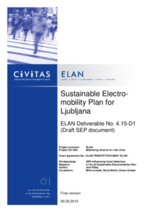Sustainable electromobility plan
Summary
With the Sustainable Electromobility Plan (SEP), Ljubljana became the first city in the country and one of the first in the new EU member states with a municipal plan on electromobility. The plan will help the municipality to incorporate the challenges arising from introduction of new technologies in modern mobility into Ljubljana long-term mobility policy.
Implementing sustainable mobility
Regardless of the plans and needs of Slovenia and its capital, the number of electric vehicles (EV) on the streets and parking lots in Ljubljana will gradually increase. EVs are ideal for city use, which is characterised by lower driving speeds and frequent stops. Besides global reduction in greenhouse gas emissions, electromobility also brings important local benefits such as reduction of road noise and air pollution.
A passive approach in the early phase of adoption of electromobility may result in unsuitable charging infrastructure development, reduced charging safety, power network overloads, etc. On top of that, any undesirable habits that EV users might acquire if the adoption of EVs remains uncontrolled may cause severe problems later on and could prove to be very difficult to change afterwards.
The Ljubljana municipality administration is aware of both: advantages of electromobility and risks of passive approach to massive introduction of electric vehicles. Therefore the City of Ljubljana (COL) decided to elaborate and adopt a »Sustainable Electromobility Plan« (SEP) which explains the advantages of electromobility, highlights the links between the EVs and the supporting infrastructure, and puts forward strategic starting points and proposals for fast, safe and organized adoption of electromobility in the city of Ljubljana. In addition, several workshops were organized and promotional materials were distributed among the citizens in order to promote electromobility and raise public awareness of its advantages.
The measures to promote electromobility are not in contradiction with the basic goal of the new COL transport policy, which is to increase the share of walking, cycling, and use of public transport in the urban mobility; however, those unable or unwilling to do so should be encouraged to use a vehicle with minimum negative impact on the environment and public health. To paraphrase: the share of passenger car use in transport should be reduced, while at the same time the number of eco-friendly (electric) vehicles within this share should increase.
Progress
The draft of Sustainable Electromobility Plan has been elaborated and discussed at a workshop in July 2012, which has been organized with the goal to collect public responses to the SEP and in general to the municipal plans related to electromobility. In May 2013, the Plan has been accepted by the City Council and hereby, electromobility became a part of strategy for better quality of life in the city.
The measures have also been presented to representatives of other major Slovenian cities in order to encourage them to introduce similar actions in their cities.
Outcomes
The Sustainable Electromobility Plan provides a framework for sustainable development of electromobility in Ljubljana by introducing strategic electromobility measures and enhancing synergies between them. A single point of contact will provide a direct interface between citizens, businesses and public services, thus accelerating a balanced evolution of electromobility in the city. The dissemination activities will raise public awareness of the advantages of electromobility, stimulate the use of environmentally friendly vehicles and eliminate the barriers currently discouraging the citizens to use new technologies in personal transport.
The successfully implemented measures, based on the Sustainable Electromobility Plan, will result in an increased share of electric vehicles on the streets of Ljubljana and consequently in reduced negative impact of transport on the citizens’ quality of life. Successful implementation will also contribute, on a local level, to tackling the global climate change.








